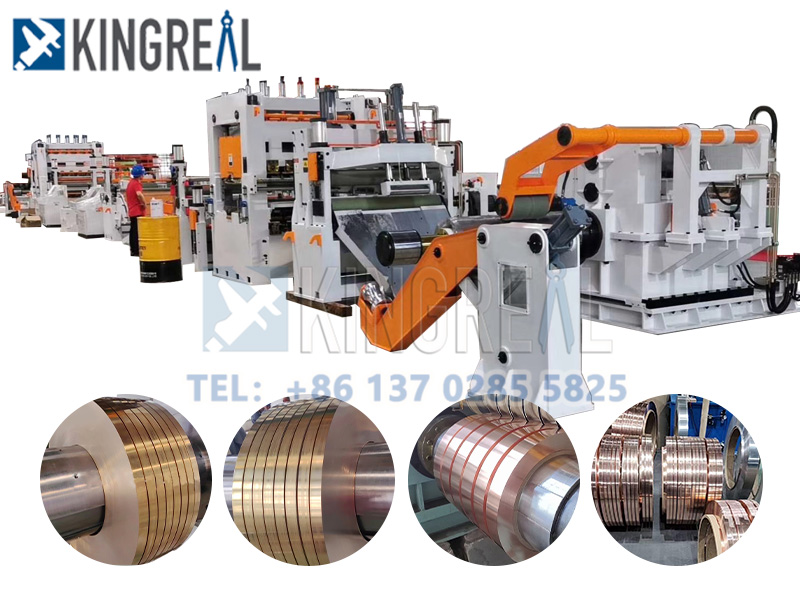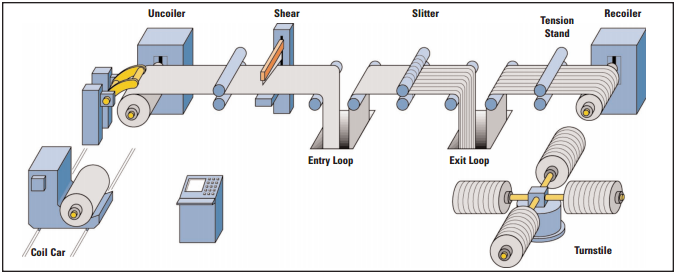How does a slitting machine work?
Coil slitting machine is a common mechanical device that is mainly used to cut large coils into the desired small coils. The working principle of the slitting line machine is to cut the coil into the desired width and length through the rotation of the cutter wheel. The rotation speed of the cutter wheel and the pressure of the blade can be adjusted according to different materials and requirements. KINGREAL is a professional coil slitting machine manufacturer. If you have any questions, please come to consult!


Coil slitter is used in paper, plastic, metal, rubber and other industries, providing convenience for production and processing. Many people just know that slitting plays a vital role in many industries, but what does it take and how does it work? This article will solve your doubts.
Understand slitting operations
Scuttling, in sheet metal manufacturing, is a shearing operation that cuts a large roll of material into a narrower roll. The process involves unrolling a large roll of metal and passing it through a series of cutters before rewinding it into smaller coils of a predetermined width.
Some common terms associated with slitting include:
Slitter: A machine for cutting metal
Slit: The act or process of cutting or a slit formed by cutting
Coil: a roll of material that is to be or has been cut
Slitting
The sashing process in sheet metal manufacturing is a specialized operation that requires a systematic approach to ensure the accuracy and quality of the output. Here, we break down the key steps involved:


Step 1: Open the book
The process begins with unwinding the raw material, which is usually a large, heavy sheet metal roll. The coil is placed on an uncoiler, also known as an uncoiler or uncoiler. The uncoiler stably unwinds the coil into a plate and feeds it into the slitter.
Key considerations in the uncoiling phase include controlling tension to prevent corrugating and ensuring that the sheet metal is fed straight into the slitter. Unwinding must be carefully done to avoid damaging the surface of the sheet metal.
Step 2: Cut
The flat metal sheet is then fed through a cutting machine, which has a series of rotating knives positioned according to the desired width of the finished coil. The distance between the knives can be adjusted according to the desired width of the final product.
The slit can be a straight cut or a circular cut, depending on the specifications of the project. The cutting must be done accurately to ensure that the final metal piece has the correct dimensions. Too wide is, waste of material; Too narrow, and the piece may not achieve its intended purpose.
Step 3: Recoil
After cutting the metal into narrower strips, roll the strips back up for easier handling and transportation. Tension control must be maintained during rewinding to prevent the sheet from wrinkling or shifting in layers.
The rewinding process also requires careful alignment to ensure that each wind is neatly wound and the strip edges are properly aligned. Proper backwinding is critical, as misalignment can cause damage to the edge of the slotted material or problems during subsequent manufacturing.
The benefits of cutting
Slitting has many advantages, making it an important process in sheet metal manufacturing. Here are some of the main advantages:

1. Efficiency and speed
Slitting enables manufacturers to cut large volumes of sheet metal quickly and efficiently. The speed at which the scuttling process is performed allows manufacturers to meet the high demand for their products without sacrificing quality.
(1) Fast production speed: slitting can quickly process large coils into smaller widths.
(2) Efficient use of materials: By cutting the coil to the precise width required for the job, waste can be minimized.
(3) The ability to handle large capacity: the slitting machine can handle large coils and is suitable for large batch operations.
2. Precision and consistency
Slitting is a high-precision process. The use of automatic slitting lines and the ability to adjust the tool spacing allow for high precision in the width of the coil produced. In addition, the consistency of the slitting process ensures the same quality of all the coils produced.
(1) Platform accuracy: Scuttling enables very precise cutting, which is crucial for industries such as automotive and HVAC, where parts often need to be assembled together with high precision.
(2) Continuous consistency: The automated nature of the slitting process ensures that every cut is consistent, thus achieving uniform quality over the entire length of the slitting material.
3. Improve material utilization
The slitting process enables manufacturers to make the most of the raw materials at their disposal. Sheet metal is cut to precise widths according to the needs of different applications, minimizing waste and ensuring maximum utilization of each sheet. This is not only cost-effective but also environmentally friendly.
4. Scalability and versatility
Slitting provides flexibility in production volumes, making it suitable for high-volume production and smaller custom orders. In addition, the process is versatile because it can accommodate a variety of metals, including stainless steel, aluminum, copper, and brass. This allows manufacturers to meet a wide range of customer needs and specifications.








 +86-137 0285 5825
+86-137 0285 5825  sales@kingreal.org
sales@kingreal.org jet-clima
jet-clima